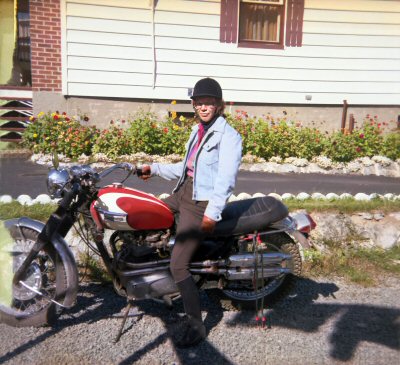 - IRC brand trial tires, 3.50x19 on the front, 5.10X18 on the back, not studded - Muffler scrambler of origin of the left side - Installation system "point breaker" original - Loward glowing incandescent lighting system - 120 watt single phase alternator - Yuasa 12N9 Basic Acid Battery To make short, the bike in 1980 consisted only of Triumph parts. Most of the original parts of the Bonneville T120 as well as some off-road parts of the Trophy Trail TR6C - Motor oil Kendall 20W50 mineral - Essence super with lead RON 98 Strike of the CTCUQ bus companies from January 29, 1979 to October 1979 http://scc-csc.lexum.com/scc-csc/scc-csc/fr/item/2506/index.do?r=AAAAAQAKUGVyc29ubmUgYgAAAAAB
http://www.subvercite.org/transport-public-a-quebec-100-ans-de-solidarite/
Temperature during winter 1979 At that time, the month of February was still the coldest month of winter, with temperatures going down to -30 ° C with no wind Click "Download Data" and you will see temperatures walking between -4 ° C to -30 ° C from February 1 to February 20 to warm up from February 21 http://climate.weather.gc.ca/historical_data/search_historic_data_f.html Daily Data Report for February 1979 in Quebec City
Adventure Details Usually I used the CTCUQ bus to go to CEGEP during the winter. Less stress and less clothes to manage. But that winter was different  My traditional red carrot coat bought
in 1973 with jeans jacket and flanalette shirt underneath
My traditional red carrot coat bought
in 1973 with jeans jacket and flanalette shirt underneathJeans with long jumpsuit underneath. Work boots with cap and steel sole Open Face helmet which was blue metal flake formerly instead of the current white With some additions to protect me from the cold temperature and calcium - Waterproof two pieces of rubber sailor. - Rubber boots that I put on over my other boots - I fixed with Duct-Tape a piece of cardboard under the visor of the helmet to simulate a closed helmet and thus better protect me from the icy wind From the slightly excessive cold of February 1979 two batteries cracked The first in early February in front of the CEGEP and the second in the middle of February in the shed. For the one at the CEGEP, in the middle of a snowstorm in the entrance and the motorcycle had been cooling for 6 hours. No battery to kick start the bike, luckily the old Triumph could start without battery as I had a system tip. I can tell you that I will remember for a long time the split battery of the CEGEP, I struggled to move the pistons with the kickstarter given the increased viscosity of the oil because of the temperature. I used the bike to go to the CEGEP 3 days out of 5 during the week In all the winter conditions you can imagine. Sloche, calcium, ice, snow, storm, winds were my daily lot I had the distance Beauport-Limoilou to cross. The first week of February I was a little stressed, but I took insurance later. Allowing me on the occasion, dancing the back of the bike on the ice and snow for fun. On weekends, I would run through snow storms to cut snow blades on my motorcycle and get even more riding experience. I felt the bike still stable and reassuring. Sometimes a few patches of black ice that dragged the bike off the two wheels. But the centrifugal force of the steel wheels prevented the motorcycle from changing its axis and falling on the sides To give you an idea of this kind of force here is a video on the gyroscopic force https://www.youtube.com/watch?v=bnvbnUrv5pU My playground and practice was by going to the rank St-Achillée at the top of Château-Richer which at the time was a gravel road along its length. It was on this road in areas of traffic that I tested the limits of traction of the bike. I stumbled a few times on the edge of the snow-covered road as a cushion to cushion my falls. Never real damage on the bike, at most the handlebar to straighten on the spot with the hands And I remember that outline of winter 1979 It was freight, snow, I had to leave the Triumph with a heater 1000 watts below the engine a good 30 minutes in the shed in the morning before starting the bike kickstarter. Usually I stayed at the CEGEP for a class, 3 hours maximum and the engine was relatively warm, except for the 6 hours that split my battery After the 2nd new battery, I made it a habit to warm it up between the ride. On the positive side, the engine was not overheating  I tried the best I could to clean the bike calcium by washing until the summer of 1980 and play in the sand of a sand pit at the top of Beauport, Quebec It was not enough, because in wet weather I saw white foam sparkling corners of the engine and the frame. I totally disassembled and repainted the fall of 1980 to stop the damage of calcium I driving the winter afterwards with not studded tires until 2008, but never as intensely as the winter of 1979 | ||||||||||||||||||||||||||||||||||||||||||||||||||||||||||||||||||||||||||||||||||||||||||||||||||||||||||||||||||||||||||||||||||||||||||||||||||||||||||||||||||||||||||||||||||||||||||||||||||||||||||||||||||||||||||||||||||||||||||||||||||||||||||||||||||||||||||||||||||||||||||||||||||||||||||||||||||||||||||||||||||||||||||||||||||||||||||||||||||||||||||||||||||||||||||||||||||||||||||||||||||||||||||||